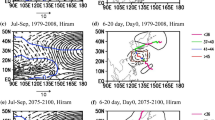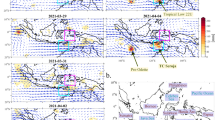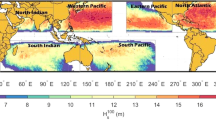Abstract
Tropical cyclones are a major hazard for numerous countries surrounding the tropical-to-subtropical North Atlantic sub-basin including the Caribbean Sea and Gulf of Mexico. Their intense winds, which can exceed 300 km h−1, can cause serious damage, particularly along coastlines where the combined action of waves, currents and low atmospheric pressure leads to storm surge and coastal flooding. This work presents future projections of North Atlantic tropical cyclone-related wave climate. A new configuration of the ARPEGE-Climat global atmospheric model on a stretched grid reaching ~ 14 km resolution to the north-east of the eastern Caribbean is able to reproduce the distribution of tropical cyclone winds, including Category 5 hurricanes. Historical (1984–2013, 5 members) and future (2051–2080, 5 members) simulations with the IPCC RCP8.5 scenario are used to drive the MFWAM (Météo-France Wave Action Model) spectral wave model over the Atlantic basin during the hurricane season. An intermediate 50-km resolution grid is used to propagate mid-latitude swells into a higher 10-km resolution grid over the tropical cyclone main development region. Wave model performance is evaluated over the historical period with the ERA5 reanalysis and satellite altimetry data. Future projections exhibit a modest but widespread reduction in seasonal mean wave heights in response to weakening subtropical anticyclone, yet marked increases in tropical cyclone-related wind sea and extreme wave heights within a large region extending from the African coasts to the North American continent.











Similar content being viewed by others
References
Alves JHGM (2006) Numerical modeling of ocean swell contributions to the global wind-wave climate. Ocean Model 11:98–122
Amrhein V et al (2019) Retire statistical significance. Nature 567:305–307. https://doi.org/10.1038/d41586-019-00857-9
Aouf L (2018) CMEMS quality information document for global ocean waves analysis and forecasting product. CMEMS-GLO-QUID-001_027 http://resources.marine.copernicus.eu/documents/QUID/CMEMS-GLO-QUID-001-027.pdf. Accessed 8 Oct 2019
Appendini CM, Pedrozo-Acuña A, Meza-Padilla R, Torres-Freyermuth A, Cerezo-Mota R, Lopez-Gonzalez J, Ruiz-Salcines P (2017) On the role of climate change on wind waves generated by tropical cyclones in the Gulf of Mexico. Coast Eng J 59:2. https://doi.org/10.1142/S0578563417400010
Ardhuin F, Rogers E, Babanin AV, Filipot JF, Magne R, Roland A, van der Westhuysen A, Queffeulou P, Lefevre JM, Aouf L, Collard F (2010) Semiempirical dissipation source functions for ocean waves. Part I: definition, calibration, and validation. J Phys Oceanogr 40(9):1917–1941
Batté L, Déqué M (2016) Randomly correcting model errors in the ARPEGE-Climate v6.1 component of CNRM-CM: applications for seasonal forecasts. Geosci Model Dev 9:2055–2076. https://doi.org/10.5194/gmd-9-2055-2016
Bieli M, Camargo SJ, Sobel AH, Evans JL, Hall T (2019a) A global climatology of extratropical transition. Part I: characteristics across basins. J Clim 32:3557–3582. https://doi.org/10.1175/JCLI-D-17-0518.1
Bieli M, Camargo SJ, Sobel AH, Evans JL, Hall T (2019b) A global climatology of extratropical transition. Part II: statistical performance of the cyclone phase space. J Clim 32:3583–3597. https://doi.org/10.1175/JCLI-D-18-0052.1
Camus P, Losada IJ, Izaguirre C, Espejo A, Menéndez M, Pérez J (2017) Statistical wave climate projections for coastal impact assessments. Earth’s Fut 5:918–933. https://doi.org/10.1002/2017EF000609
Cantet P, Déqué M, Palany P, Maridet JL (2014) The importance of using a high-resolution model to study the climate change on small islands: the lesser antilles case. Tellus A 66:24065. https://doi.org/10.3402/tellusa.v66.24065
Cantet P, Belmadani A, Chauvin F, Palany P (2020) Projections of tropical cyclone rainfall over land with an Eulerian approach: case study of three islands in the West Indies. Int J Climatol 1–11. https://doi.org/10.1002/joc.6760
Charles E, Idier D, Delecluse P, Déqué M, Le Cozannet G (2012) Climate change impact on waves in the Bay of Biscay, France. Ocean Dyn 62:831–848. https://doi.org/10.1007/s10236-012-0534-8
Chauvin F, Royer JF, Déqué D (2006) Response of hurricane-type vortices to global warming as simulated by ARPEGE-Climat at high resolution. Clim Dyn 27:377–399
Chauvin F, Pilon R, Palany P, Belmadani A (2020) Future changes in Atlantic hurricanes with the rotated-stretched ARPEGE-Climat at very high resolution. Clim Dyn 54:947–972. https://doi.org/10.1007/s00382-019-05040-4
Chen Y, Yu X (2017) Sensitivity of storm wave modeling to wind stress evaluation methods. J Adv Model Earth Sys 9:893–907. https://doi.org/10.1002/2016MS000850
Chen X, Ginis I, Hara T (2018) Sensitivity of offshore tropical cyclone wave simulations to spatial resolution in wave models. J Mar Sci Eng 6:116. https://doi.org/10.3390/jmse6040116
Christensen JH, Krishna Kumar K, Aldrian E, An SI, Cavalcanti IFA, de Castro M, Dong W, Goswami P, Hall A, Kanyanga JK, Kitoh A, Kossin J, Lau NC, Renwick J, Stephenson DB, Xie SP, Zhou T (2013) Climate phenomena and their relevance for future regional climate change. In: Stocker, TF, Qin D, Plattner GK, Tignor M, Allen SK, Boschung J, Nauels A, Xia Y, Bex V, Midgley PM (eds) Climate change 2013: the physical science basis. Contribution of working group I to the fifth assessment report of the intergovernmental panel on climate change. Cambridge University Press, Cambridge, United Kingdom and New York, NY, USA
Church JA, Clark PU, Cazenave A, Gregory JM, Jevrejeva S, Levermann A, Merrifield MA, Milne GA, Nerem RS, Nunn PD, Payne AJ, Pfeffer WT, Stammer D, Unnikrishnan AS (2013) Sea level change. In: Stocker, TF, Qin D, Plattner GK, Tignor M, Allen SK, Boschung J, Nauels A, Xia Y, Bex V, Midgley PM (eds) Climate change 2013: the physical science basis. Contribution of working group I to the fifth assessment report of the intergovernmental panel on climate change. Cambridge University Press, Cambridge, United Kingdom and New York, NY, USA
Dee DP et al (2011) The ERA-Interim reanalysis: configuration and performance of the data assimilation system. Q J R Meteorol Soc A 137:553–597. https://doi.org/10.1002/qj.828
Déqué M (2007) Frequency of precipitation and temperature extremes over France in an anthropogenic scenario: model results and statistical correction according to observed values. Glob Planet Chang 57:16–26
Diro GT, Giorgi F, Fuentes-Franco R, Walsh KJE, Giuliani G, Coppola E (2014) Tropical cyclones in a regional climate change projection with RegCM4 over the CORDEX Central America domain. Clim Change 125:79–94. https://doi.org/10.1007/s10584-014-1155-7
Dodet G et al (2020) The Sea State CCI dataset v1: towards a sea state climate data record based on satellite observations. Earth Sys Sci Data 12:1929–1951. https://doi.org/10.5194/essd-12-1929-2020
Emanuel KA (2013) Downscaling CMIP5 climate models shows increased tropical cyclone activity over the 21st century. Proc Natl Acad Sci USA 110:12219–12224. https://doi.org/10.1073/pnas.1301293110
Fan Y, Held IM, Lin SJ, Wang XL (2013) Ocean warming effect on surface gravity wave climate change for the end of the twenty-first century. J Clim 26:6046–6066
Fan Y, Lin SJ, Griffies SM, Hemer MA (2014) Simulated global swell and wind-sea climate and their responses to anthropogenic climate change at the end of the twenty-first century. J Clim 27:3516–3536
Gastineau G, Li L, Le Treut H (2009) The Hadley and Walker circulation changes in global warming conditions described by idealized atmospheric simulations. J Clim 22:3993–4013. https://doi.org/10.1175/2009JCLI2794.1
Guo L, Perrie W, Long Z, Toulany B, Sheng J (2015) The impacts of climate change on the autumn North Atlantic wave climate. Atmos Ocean 53:491–509. https://doi.org/10.1080/07055900.2015.1103697
Harris DL (1963) Characteristics of the hurricane storm surge. Tech Rep 48, US Weather Bureau, Department of Commerce, Washington, DC
Hasselmann S, Brüning C, Hasselmann K, Heimbach P (1996) An improved algorithm for retrieval of ocean wave spectra from synthetic aperture radar image spectra. J Geophys Res 101:16615–16629
Hemer MA, Trenham CE (2016) Evaluation of a CMIP5 derived dynamical global wind wave climate model ensemble. Ocean Model 103:190–203. https://doi.org/10.1016/j.ocemod.2015.10.009
Hemer MA, Katzfey J, Trenham CE (2013a) Global dynamical projections of surface ocean wave climate for a future high greenhouse gas emission scenario. Ocean Model 70:221–245. https://doi.org/10.1016/j.ocemod.2012.09.008
Hemer M, Fan Y, Mori N, Semedo A, Wang X (2013b) Projected changes in wave climate from a multi-model ensemble. Nat Clim Change. https://doi.org/10.1038/nclimate1791
Hemer M, Wang W, Charles E, Hegermiller C & COWCLIP contributors (2014) Report of the 2014 meeting for the WCRP-JCOMM Coordinated Global Wave Climate Projections (COWCLIP), WMO 2014.
Hemer M, Wang X, Webb A and COWCLIP contributors (2018) Report of the 2018 meeting for the WCRP-JCOMM Coordinated Global Wave Climate Projections (COWCLIP), WMO 2018
Hersbach H et al (2020) The ERA5 global reanalysis. Q J R Meteorol Soc. https://doi.org/10.1002/qj.3803
Johanson CM, Fu Q (2009) Hadley cell widening: model simulations versus observations. J Clim 22:2713–2725. https://doi.org/10.1175/2008JCLI2620.1
Jullien S, Marchesiello P, Menkes CE, Lefèvre J, Jourdain NC, Samson G, Lengaigne M (2014) Ocean feedback to tropical cyclones: climatology and processes. Clim Dyn 43:2831–2854. https://doi.org/10.1007/s00382-014-2096-6
Jury MR (2018) Characteristics and meteorology of Atlantic swells reaching the Caribbean. J Coastal Res 34:400–412. https://doi.org/10.2112/JCOASTRES-D-17-00029.1
Kar-Man Chang E (2018) CMIP5 projected change in Northern Hemisphere winter cyclones with associated extreme winds. J Clim 31:6527–6542
Kishimoto R, Shimura T, Mori N, Mase H (2017) Statistical modeling of global mean wave height considering principal component analysis of sea level pressures and its application to future wave height projection. Hydrol Res Lett 11:51–57. https://doi.org/10.3178/HRL.11.51
Knapp KR, Kruk MC, Levinson DH, Diamond HJ, Neumann CJ (2010) The international best track archive for climate stewardship (IBTrACS): unifying tropical cyclone data. Bull Am Meteorol Soc 91:363–376. https://doi.org/10.1175/2009BAMS2755.1
Komar PD (1998) Beach processes and sedimentation. Prentice-Hall, Upper Saddle River, NJ, 2nd edn. pp. 546, ISBN 0-13754-938-5
Krien Y, Arnaud G, Cécé R, Ruf C, Belmadani A, Khan J, Bernard D, Islam AKMS, Durand F, Testut L, Palany P, Zahibo N (2018) Can we improve parametric cyclonic wind fields using recent satellite remote sensing data? Remote Sens 10:1963. https://doi.org/10.3390/rs10121963
Laugel A, Menendez M, Benoit M, Mattarolo G, Méndez F (2014) Wave climate projections along the French coastline: dynamical versus statistical downscaling methods. Ocean Model 84:35–50. https://doi.org/10.1016/j.ocemod.2014.09.002
Lemos G, Menendez M, Semedo A, Camus P, Hemer M, Dobrynin M, Miranda PMA (2020) On the need of bias correction methods for wave climate projections. Glob Planet Chang 186. https://doi.org/10.1016/j.gloplacha.2019.103109
Moon I, Hara T, Ginis I, Belcher SE, Tolman HL (2004) Effect of surface waves on air-sea momentum exchange: I. Effect of mature and growing seas. J Atmos Sci 61(19):2321–2333
Mori N, Yasuda T, Mase H, Tom T, Oku Y (2010) Projection of extreme wave climate change under global warming. Hydrol Res Lett 4:15–19. https://doi.org/10.3178/HRL.4.15
Mori N, Shimura T, Yasuda T, Mase H (2013) Multi-model climate projections of ocean surface variables under different climate scenarios–future change of waves, sea level and wind. Ocean Eng 71:122–129. https://doi.org/10.1016/j.oceaneng.2013.02.016
Morim J, Hemer M, Cartwright N, Strauss D, Andutta F (2018) On the concordance of 21st century wind-wave climate projections. Global Planet Change 167:160–171
Morim J, Hemer M, Wang XL, Cartwright N, Trenham C, Semedo A, Young I, Bricheno L, Camus P, Casas-Prat M, Erikson L, Mentaschi L, Mori N, Shimura T, Timmermans B, Aarnes O, Breivik O, Behrens A, Dobrynin M, Menendez M, Staneva J, Wehner M, Wolf J, Kamranzad B, Webb A, Stopa J, Andutta F (2019) Robustness and uncertainties in global multivariate wind-wave climate projections. Nat Clim Change. https://doi.org/10.1038/s41558-019-0542-5
Murakami H, Mizuta R, Shindo E (2012) Future changes in tropical cyclone activity projected by multi-physics and multi-SST ensemble experiments using the 60-km-mesh MRI-AGCM. Clim Dyn 39:2569–2584. https://doi.org/10.1007/s00382-011-1223-x
Perez J, Menendez M, Losada IJ (2017) GOW2: a global wave hindcast for coastal applications. Coastal Eng 124:1–11. https://doi.org/10.1016/j.coastaleng.2017.03.005
Piolle JF, Dodet G, Ash E (2020) ESA Sea State Climate Change Initiative: Product user guide, version 1.0. http://dap.ceda.ac.uk/thredds/fileServer/neodc/esacci/sea_state/docs/v1.1/Sea_State_cci_PUG_v1.0-signed.pdf. Accessed 21 Mar 2020
Powell MD, Vickery PJ, Reinhold TA (2003) Reduced drag coefficient for high wind speeds in tropical cyclones. Nature 422(6929):279–283
Rappaport EN (2014) Fatalities in the United States from Atlantic tropical cyclones: new data and interpretation. Bull Am Meteorol Soc 95:341–346. https://doi.org/10.1175/BAMS-D-12-00074.1
Rayner NA, Parker DE, Horton EB, Folland CK, Alexander LV, Rowell DP, Kent EC, Kaplan A (2003) Global analyses of sea surface temperature, sea ice, and night marine air temperature since the late nineteenth century. J Geophys Res 108:4407. https://doi.org/10.1029/2002JD002670
Rey T, Leone F, Candela T, Belmadani A, Palany P, Krien Y, Cécé R, Gherardi M, Péroche M, Zahibo N (2019) Coastal processes and influence on damage to urban structures during Hurricane Irma (St-Martin & St-Barthélemy, French West Indies). J Mar Sci Eng 7:215. https://doi.org/10.3390/jmse7070215
Roberts MJ et al (2020a) Impact of model resolution on tropical cyclone simulation using the HighResMIP–PRIMAVERA multimodel ensemble. J Clim 33:2557–2583. https://doi.org/10.1175/JCLI-D-19-0639.1
Roberts MJ et al (2020b) Projected future changes in tropical cyclones using the CMIP6 HighResMIP multi-model ensemble. Geophys Res Lett 47:e2020GL088662. https://doi.org/10.1029/2020GL088662
Roehrig R et al (2020) The CNRM global atmosphere model ARPEGE-Climat 6.3: description and evaluation. J Adv Model Earth Sys 12:e2020MS002075. https://doi.org/10.1029/2020MS002075
Scoccimarro E, Gualdi S, Bellucci A, Sanna A, Fogli PG, Manzini E, Vichi M, Oddo P, Navarra A (2011) Effects of tropical cyclones on ocean heat transport in a high-resolution coupled general circulation model. J Clim 24:4368–4384. https://doi.org/10.1175/2011jcli4104.1
Semedo A, Sušelj K, Rutgersson A, Sterl A (2011) A global view on the wind sea and swell climate and variability from ERA-40. J Clim 24:1461–1479. https://doi.org/10.1175/2010JCLI3718.1
Semedo A, Weisse R, Behrens A, Sterl A, Bengtsson L, Günther H (2013) Projection of global wave climate change toward the end of the twenty-first century. J Clim 26:8269–8288. https://doi.org/10.1175/JCLI-D-12-00658.1
Semedo A, Dobrynin M, Lemos G, Behrens A, Staneva J, De Vries H, Sterl A, Bidlot JR, Miranda PMA, Murawski J (2018) CMIP5-derived single-forcing, single-model, and single-scenario wind-wave climate ensemble: configuration and performance evaluation. J Mar Sci Eng 6:90. https://doi.org/10.3390/jmse6030090
Shimura T, Mori N, Mase H (2015) Future projections of extreme ocean wave climates and the relation to tropical cyclones: ensemble experiments of MRI-AGCM3.2H. J Clim 28:9838–9856
Stockdon HF, Holman RA, Howd PA, Sallenger AH (2006) Empirical parameterization of setup, swash, and runup. Coastal Eng 53:573–588
Stockdon HF, Thompson DM, Plant NG, Long JW (2014) Evaluation of wave runup predictions from numerical and parametric models. Coastal Eng 92:1–11
Stopa JE (2018) Wind forcing calibration and wave hindcast comparison using multiple reanalysis and merged satellite wind datasets. Ocean Model 127:55–69. https://doi.org/10.1016/j.ocemod.2018.04.008
Timmermans B, Stone D, Wehner M, Krishnan H (2017) Impact of tropical cyclones on modeled extreme wind-wave climate. Geophys Res Lett 44:1393–1401. https://doi.org/10.1002/2016GL071681
Timmermans BW, Gommenginger CP, Dodet G, Bidlot JR (2020) Global wave height trends and variability from new multimission satellite altimeter products, reanalyses, and wave buoys. Geophys Res Lett 47. https://doi.org/10.1029/2019GL086880
Voldoire A et al (2019) Evaluation of CMIP6 DECK experiments with CNRM-CM6-1. J Adv Model Earth Sys 11(7):2177–2213
Vousdoukas MI, Mentaschi L, Voukouvalas E, Verlaan M, Jevrejeva S, Jackson LP, Feyen L (2018a) Global probabilistic projections of extreme sea levels show intenseification of coastal flood hazard. Nat Comm 9:2360. https://doi.org/10.1038/s41467-018-04692-w
Vousdoukas MI, Mentaschi L, Voukouvalas E, Bianchi A, Dottori F, Feyen L (2018b) Climatic and socioeconomic controls of future coastal flood risk in Europe. Nat Clim Change 8:776–780. https://doi.org/10.1038/s41558-018-0260-4
WAMDI Group (1988) The WAM model: a third-generation ocean wave prediction model. J Phys Oceanogr 18:1775–1810
Wang XL, Feng Y, Swail VR (2014) Changes in global ocean wave heights as projected using multimodel CMIP5 simulations. Geophys Res Lett 41:1026–1034. https://doi.org/10.1002/2013GL058650
Wang XL, Feng Y, Swail VR (2015) Climate change signal and uncertainty in CMIP5-based projections of global ocean surface wave heights. J Geophys Res Oceans 120:3859–3871. https://doi.org/10.1002/2015JC010699
Webb A, Shimura T, Mori N (2018) A high-resolution future wave climate projection for the coastal northwestern Atlantic. J Japan Soc Civil Eng, Ser B2 (Coastal Eng) 74:1345–1350. https://doi.org/10.2208/kaigan.74.I_1345
Wehner M, Prabhat RKA, Stone D, Collins WD, Bacmeister J (2015) Resolution dependence of future tropical cyclone projections of CAM5.1 in the U.S. CLIVAR hurricane working group idealized configurations. J Clim 28:3905–3925. https://doi.org/10.1175/JCLI-D-14-00311.1
World Meteorological Organization (2014) Atlas of mortality and economic losses from weather, climate and water extremes (1970–2012). WMO-No. 1123
Zelinsky DA (2019) Hurricane Lorenzo. Tropical Cyclone Report, National Hurricane Center, Miami, FL, USA. Available online: https://www.nhc.noaa.gov/data/tcr/AL132019_Lorenzo.pdf. Accessed 1 Jun 2020
Acknowledgements
We are grateful to two anonymous reviewers whose detailed and constructive comments greatly helped improve the quality of the original manuscript. We acknowledge L. Aouf for advice with MFWAM calibration/validation, D. Paradis, P. Cantet and R. Osinski for fruitful discussions, and P.-C. Dutrieux for help with post-processing algorithms. The altimeter wave data were obtained from the ESA CCI Sea State project. This effort is sponsored by the European Regional Development Fund, Guadeloupe region, grant CR/16-115 C3AF (Changement Climatique et Conséquences sur les Antilles Françaises).
Author information
Authors and Affiliations
Corresponding author
Additional information
Publisher's Note
Springer Nature remains neutral with regard to jurisdictional claims in published maps and institutional affiliations.
Supplementary Information
Below is the link to the electronic supplementary material.
382_2021_5664_MOESM1_ESM.pdf
Supplementary file 1 Fig. S1. Projected changes in decorrelation time scales (days) for hurricane-season a) surface wind speed U10 fromARPEGE-Climat, b) significant wave height Hs and c) mean wave period Tm from MFWAM05 between W-RCP8.5(2051-2080) and W-Hist-Model (1984-2013). W-Hist-Model values are overlaid as black contours. ARPEGE-Climat data are masked over land (PDF 435 KB)
382_2021_5664_MOESM2_ESM.png
Supplementary file 2 Fig. S2. Differences in the mean present-climate (1984-2013) hurricane-season surface winds (arrows) and wind speed U10 (shading) between Hist-Obs and ERA5. ERA5 values for U10 are overlaid as black contours. The data have been interpolated onto a 0.5° grid, and are masked over land. The arrows are for the difference in wind vectors. Units are m.s-1 (PNG 250 KB)
382_2021_5664_MOESM3_ESM.pdf
Supplementary file 3 Fig. S3. Differences in the a) mean and b) standard deviation of 1991-2013 ASO significant wave height Hs (m)between MFWAM05 W-Hist-Obs and ESA Sea State CCI (shading), with ESA Sea State CCI values overlaid as blackcontours. The MFWAM05 data have been interpolated onto a 1° grid. Differences exceeding +/-0.6 m are masked inwhite (PDF 377 KB)
382_2021_5664_MOESM4_ESM.pdf
Supplementary file 4 Fig. S4. Same as Fig. 9ac, except for (a,c) significant height of primary swell Hs1 (m) and (b,d) mean wave period Tm(s) (PDF 362 KB)
382_2021_5664_MOESM5_ESM.pdf
Supplementary file 5 Fig. S5. Same as Fig. 10ab, except for significant height of (a,b) primary swell Hs1 and (c,d) wind waves Hs0 (m). (PDF 500 KB)
Rights and permissions
About this article
Cite this article
Belmadani, A., Dalphinet, A., Chauvin, F. et al. Projected future changes in tropical cyclone-related wave climate in the North Atlantic. Clim Dyn 56, 3687–3708 (2021). https://doi.org/10.1007/s00382-021-05664-5
Received:
Accepted:
Published:
Issue Date:
DOI: https://doi.org/10.1007/s00382-021-05664-5




